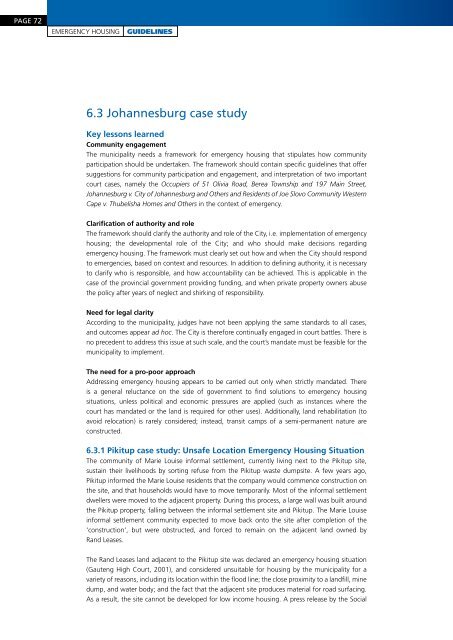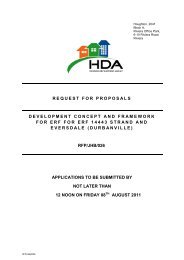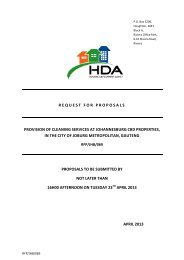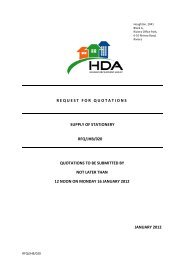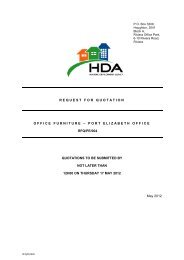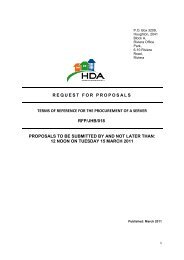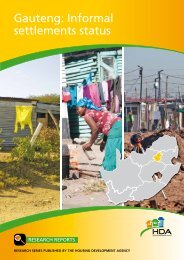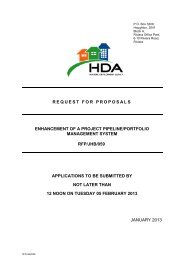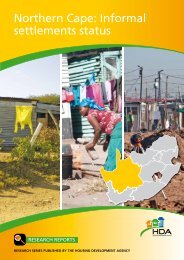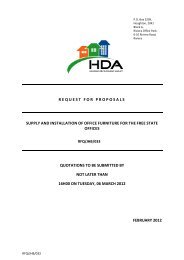Implementation of emergency housing - Housing Development ...
Implementation of emergency housing - Housing Development ...
Implementation of emergency housing - Housing Development ...
You also want an ePaper? Increase the reach of your titles
YUMPU automatically turns print PDFs into web optimized ePapers that Google loves.
page 72<strong>emergency</strong> <strong>housing</strong>guidelines6.3 Johannesburg case studyKey lessons learnedCommunity engagementThe municipality needs a framework for <strong>emergency</strong> <strong>housing</strong> that stipulates how communityparticipation should be undertaken. The framework should contain specific guidelines that <strong>of</strong>fersuggestions for community participation and engagement, and interpretation <strong>of</strong> two importantcourt cases, namely the Occupiers <strong>of</strong> 51 Olivia Road, Berea Township and 197 Main Street,Johannesburg v. City <strong>of</strong> Johannesburg and Others and Residents <strong>of</strong> Joe Slovo Community WesternCape v. Thubelisha Homes and Others in the context <strong>of</strong> <strong>emergency</strong>.Clarification <strong>of</strong> authority and roleThe framework should clarify the authority and role <strong>of</strong> the City, i.e. implementation <strong>of</strong> <strong>emergency</strong><strong>housing</strong>; the developmental role <strong>of</strong> the City; and who should make decisions regarding<strong>emergency</strong> <strong>housing</strong>. The framework must clearly set out how and when the City should respondto emergencies, based on context and resources. In addition to defining authority, it is necessaryto clarify who is responsible, and how accountability can be achieved. This is applicable in thecase <strong>of</strong> the provincial government providing funding, and when private property owners abusethe policy after years <strong>of</strong> neglect and shirking <strong>of</strong> responsibility.Need for legal clarityAccording to the municipality, judges have not been applying the same standards to all cases,and outcomes appear ad hoc. The City is therefore continually engaged in court battles. There isno precedent to address this issue at such scale, and the court’s mandate must be feasible for themunicipality to implement.The need for a pro-poor approachAddressing <strong>emergency</strong> <strong>housing</strong> appears to be carried out only when strictly mandated. Thereis a general reluctance on the side <strong>of</strong> government to find solutions to <strong>emergency</strong> <strong>housing</strong>situations, unless political and economic pressures are applied (such as instances where thecourt has mandated or the land is required for other uses). Additionally, land rehabilitation (toavoid relocation) is rarely considered; instead, transit camps <strong>of</strong> a semi-permanent nature areconstructed.6.3.1 Pikitup case study: Unsafe Location Emergency <strong>Housing</strong> SituationThe community <strong>of</strong> Marie Louise informal settlement, currently living next to the Pikitup site,sustain their livelihoods by sorting refuse from the Pikitup waste dumpsite. A few years ago,Pikitup informed the Marie Louise residents that the company would commence construction onthe site, and that households would have to move temporarily. Most <strong>of</strong> the informal settlementdwellers were moved to the adjacent property. During this process, a large wall was built aroundthe Pikitup property, falling between the informal settlement site and Pikitup. The Marie Louiseinformal settlement community expected to move back onto the site after completion <strong>of</strong> the‘construction’, but were obstructed, and forced to remain on the adjacent land owned byRand Leases.The Rand Leases land adjacent to the Pikitup site was declared an <strong>emergency</strong> <strong>housing</strong> situation(Gauteng High Court, 2001), and considered unsuitable for <strong>housing</strong> by the municipality for avariety <strong>of</strong> reasons, including its location within the flood line; the close proximity to a landfill, minedump, and water body; and the fact that the adjacent site produces material for road surfacing.As a result, the site cannot be developed for low income <strong>housing</strong>. A press release by the Social


